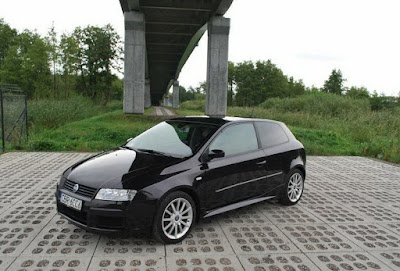
Fiat Stilo Abarth
The Stilo's styling received mixed reviews, with many journalists and enthusiasts criticising it as being too bland and too German looking, somewhat ironically, as the styling of the preceding Bravo and Brava had been criticised for being too "Italian".
Critics also attacked the car's excessive weight and its semi independent rear torsion beam suspension / twist-beam rear suspension, (like a previous generation Volkswagen Golf), which was seen as a step backwards from the acclaimed fully independent rear suspension used in the Bravo/Brava, and which resulted in handling many found uninspired and uninvolving, although the Bravo/Brava IRS setup was prone to suspension bush wear.
The engine range, particularly the 1.2 litre petrol, was also criticised for being underpowered. The car's fuel economy was also seen as poor for its class, a result of the car's heavy weight and the transmission, which used very long gear ratios. Another point of criticism was the Selespeed gearbox, which was seen as too slow in its reactions and particularly inappropriate for the high powered Abarth version. Nevertheless, the car won praise for its high levels of grip aided by the unusually wide tires and its brakes.
In the United Kingdom, different trim levels available were: Active, Active Aircon, Blue, Dynamic, Sporting, Abarth, GT, Prestigio, Xbox limited edition, Michael Schumacher and the Schumacher GP, with general modifications by British car specialists, Prodrive.
The Stilo was the second car worldwide to use the TRW Column-Drive Electric Power Assisted Steering (EPS) technology after the second generation Fiat Punto, later introduced on the 2003 Nissan Micra and Renault Mégane.
As the model range aged, the range of available options was reduced. The Stilo was originally offered in some markets with a radar-assisted cruise control option; it included sensors in the front bumper and rear of the car to adjust the speed of the car according to other vehicles' speed.[citation needed] This was soon[when?] dropped as it became apparent that interference was creating undesired results.[citation needed] A keyless entry, named 'Easy Go', push button start, similar in function to Citroën's, Mercedes-Benz's and BMW Mini's systems, was also an available option.
Critics also attacked the car's excessive weight and its semi independent rear torsion beam suspension / twist-beam rear suspension, (like a previous generation Volkswagen Golf), which was seen as a step backwards from the acclaimed fully independent rear suspension used in the Bravo/Brava, and which resulted in handling many found uninspired and uninvolving, although the Bravo/Brava IRS setup was prone to suspension bush wear.
The engine range, particularly the 1.2 litre petrol, was also criticised for being underpowered. The car's fuel economy was also seen as poor for its class, a result of the car's heavy weight and the transmission, which used very long gear ratios. Another point of criticism was the Selespeed gearbox, which was seen as too slow in its reactions and particularly inappropriate for the high powered Abarth version. Nevertheless, the car won praise for its high levels of grip aided by the unusually wide tires and its brakes.
In the United Kingdom, different trim levels available were: Active, Active Aircon, Blue, Dynamic, Sporting, Abarth, GT, Prestigio, Xbox limited edition, Michael Schumacher and the Schumacher GP, with general modifications by British car specialists, Prodrive.
The Stilo was the second car worldwide to use the TRW Column-Drive Electric Power Assisted Steering (EPS) technology after the second generation Fiat Punto, later introduced on the 2003 Nissan Micra and Renault Mégane.
As the model range aged, the range of available options was reduced. The Stilo was originally offered in some markets with a radar-assisted cruise control option; it included sensors in the front bumper and rear of the car to adjust the speed of the car according to other vehicles' speed.[citation needed] This was soon[when?] dropped as it became apparent that interference was creating undesired results.[citation needed] A keyless entry, named 'Easy Go', push button start, similar in function to Citroën's, Mercedes-Benz's and BMW Mini's systems, was also an available option.




No comments:
Post a Comment